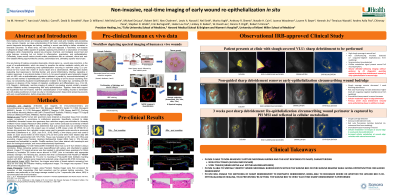Clinical Research
(CR-022) Non-invasive, real-time imaging of early wound re-epithelialization in situ.
Friday, April 28, 2023
7:15 PM - 8:30 PM East Coast USA Time

Ivan Jozic, Ph.D. – Assistant Professor, Dermatology, Univ Miami Miller School of Medicine; Molly Carroll, Ph.D. – Senior Scientist, Precision Healing, Inc; David Strasfeld, Ph.D. – VP, Precision Healing, Inc; Mel McCurrie, MS – Principal Computer Vision Engineer, Precision Healing, Inc; Michael DeLuca, Ph.D. – Senior Engineer, Precision Healing, Inc; Ryan Williams, Ph.D. – Director, Precision Healing, Inc; Robert Brik, Ph.D. – Director Mechanical Engineering, Precision Healing, Inc; Alex Chalmers, Ph.D. – Principal Platform Engineer/Architect, Precision Healing, Inc; Lewis Novack, MS – Research Coordinator, Brigham & Women's Hospital; Neil Seth, M.D. – Univ Miami Miller School of Medicine; Marita Yaghi, M.D. – Clinical Research Fellow, Univ Miami Miller School of Medicine; Anthony Sheets, M.D./Ph.D. – Clinical Research Fellow, Brigham & Women's Hospital; Natalie Cain, PA-C – Brigham & Women's Hospital; Joanna Woodman, R.N. – Brigham & Women's Hospital; Lauren Bayer, PA-C – Brigham & Women's Hospital; Hannah Jin, M.P.H. – Brigham & Women's Hospital; Tenaizus Woods, BA; Andres Avila Paz, B.A.; Chinmay Patel, B.A.; Stephen Walsh, M.D. – Brigham & Women's Hospital; Erin Bertagnolli, PA-C – Brigham & Women's Hospital; W. David Lee, MBA, MS – CEO, Precision Healing, Inc; Hadar Lev-Tov, M.D./Ph.D. – Professor, Univ Miami Miller School of Medicine; Lindsey Baden, M.D. – Vice President Clinical Affairs, Brigham & Women's Hospital; Dennis Orgill, M.D./Ph.D. – Professor/Director, Brigham & Women's Hospital; Robert Kirsner, M.D./Ph.D. – Chairman, Dermatology, Univ Miami Miller School of Medicine
Introduction: Non-healing wounds remain an increasing problem with care costs and mortality rates exceeding many cancers. Despite our deep understanding of the factors controlling healing, comprehensive wound diagnostic technologies are lacking, resulting in wound care failing to deliver consistent or favorable outcomes.
Methods: To these ends, we have built and deployed a hand-held, non-invasive multispectral imager (MSI) capable of spatially capturing the presence or abundance of microbial pathogens while characterizing several key physical, chemical, and biological wound bed and edge features, including but not limited to inflammation, granulation, and epithelialization. One key feature of healing, preceding observable, clinical signs (i.e., wound area reduction), is the onset of re-epithelialization, which we aimed to visualize via cellular metabolic activity with our MSI. We report on characterizing early epithelialization occurring in real-time using: (i) a pre-clinical ex-vivo human skin model of wound repair and ii) observational, IRB-approved studies evaluating host responses to microbial burden, and wound inflammatory, infective, reparative or healing responses. In pre-clinical studies, 8 mm by 3 mm wound explants were temporally imaged with our MSI, with re-epithelialization signatures validated in parallel by immunohistochemistry of early and late markers of epithelialization.
Results: With real-time imaging of ex-vivo tissue recovering from injury, we consistently visualized re-epithelialization invisible to the naked eye, correlating with the presence or absence of the markers of migration, proliferation and differentiation (e.g., K14, K6, K10, filaggrin). Additionally, real-time imaging of patients’ non-healing wounds similarly revealed cellular metabolic activity corresponding with early epithelialization.
Discussion: Together, these data support the hypothesis that non-invasive, real-time characterization of non-healing, stalled or healing wounds is achievable. Enabling practitioners with the opportunity to remove devitalized or microbially-burdened tissue while preserving those wound domains or margins with early re-epithelialization, and before any changes in wound diameter might be clinically observable should prove beneficial for hastened healing. These collective wound metrics should provide practitioners with unbiased, robust and real-time data leading to precise, personalized and hopefully, superior wound care.
Methods: To these ends, we have built and deployed a hand-held, non-invasive multispectral imager (MSI) capable of spatially capturing the presence or abundance of microbial pathogens while characterizing several key physical, chemical, and biological wound bed and edge features, including but not limited to inflammation, granulation, and epithelialization. One key feature of healing, preceding observable, clinical signs (i.e., wound area reduction), is the onset of re-epithelialization, which we aimed to visualize via cellular metabolic activity with our MSI. We report on characterizing early epithelialization occurring in real-time using: (i) a pre-clinical ex-vivo human skin model of wound repair and ii) observational, IRB-approved studies evaluating host responses to microbial burden, and wound inflammatory, infective, reparative or healing responses. In pre-clinical studies, 8 mm by 3 mm wound explants were temporally imaged with our MSI, with re-epithelialization signatures validated in parallel by immunohistochemistry of early and late markers of epithelialization.
Results: With real-time imaging of ex-vivo tissue recovering from injury, we consistently visualized re-epithelialization invisible to the naked eye, correlating with the presence or absence of the markers of migration, proliferation and differentiation (e.g., K14, K6, K10, filaggrin). Additionally, real-time imaging of patients’ non-healing wounds similarly revealed cellular metabolic activity corresponding with early epithelialization.
Discussion: Together, these data support the hypothesis that non-invasive, real-time characterization of non-healing, stalled or healing wounds is achievable. Enabling practitioners with the opportunity to remove devitalized or microbially-burdened tissue while preserving those wound domains or margins with early re-epithelialization, and before any changes in wound diameter might be clinically observable should prove beneficial for hastened healing. These collective wound metrics should provide practitioners with unbiased, robust and real-time data leading to precise, personalized and hopefully, superior wound care.

.png)